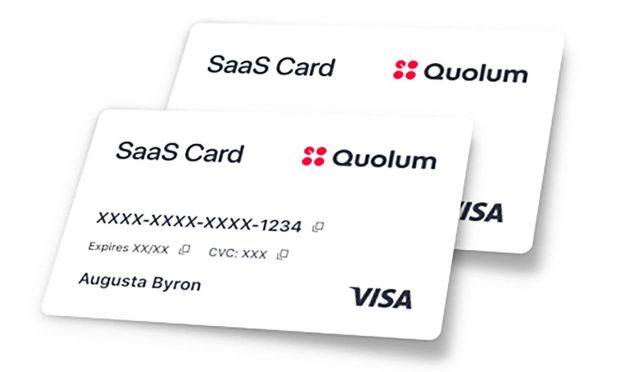Beyond T&E, New Corporate Card Tracks Utilization, Compliance Of SaaS and Cloud Subscription Spend

Let’s say you were the chief financial officer of a company that has 200 employees, each with 5 different subscriptions and licenses to things like Outlook, Zoom and other software or cloud-based service that require a monthly payment.
Historically, over the course of a year, those 12,000 hypothetical payments would likely have been processed through a traditional corporate credit card, with each expense vaguely labeled and strewn alongside a mix of company lunches, plane tickets and office supplies.
It’s easy to see how managing that spending quagmire would be less than optimal and why a company like Quolum decided to step up and address the problem with what it calls “the world’s only expense card for purchasing and managing SaaS subscriptions.”
“Current corporate cards are not designed for you to go back and check whether you’re paying for a transaction which is legit, or if the merchant is the same, or if the product and policies are compliant,” Indus Khaitan, founder and CEO of Quolum, told PYMNTS ahead of the company’s SaaS Card debut Wednesday (Sept. 15).
By design, the California-based startup’s virtual corporate expense card doesn’t just help businesses purchase and monitor subscriptions. It goes even further by tracking employee utilization, multi-tier pricing, and other risk and compliance updates that are constantly being updated.
See also: New Report Shows 36% of Businesses Plan to Upgrade Spend Management, Expense Controls
It’s a virtual card that Khaitan said was “hyper-designed” to allow businesses to see whether an employee is still using the product after the initial purchase and whether all of the features being paid for are actually necessary.
“We thought there’s a use case to help businesses to come together beyond just an Uber ride or travel that you use corporate cards for,” Khaitan said. “So, that’s what we are going after.”
Purchasing and Monitoring
Khaitan describes Quolum’s SaaS card as a frontend purchasing card that has been combined with a backend monitoring software stack that examined hundreds of the most common enterprise SaaS purchases listed within its catalog of over 32,000 different titles and providers.
To help control expenditures, the card gives the finance department a better idea of what software products are being used and why. Rather than seeing them all simply identified and line-itemed as “software,” Quolum adds a full product description and annotation to each transaction.
“The expenditure becomes a problem because they don’t have clear visibility into what is being paid for and why it is being paid for,” Khaitan explained. “So we come in and, using our catalog, we further annotate the product.”
On the utilization front, the SaaS card tracks canceled services when employees leave the company, and in the case where a tiered-service plan is available, it determines if the Gold plan is needed when the Bronze might suffice.
“We bring it 360 degrees by saying, ‘You are spending $500 on this product but you’re only using $300 worth of the product.’ This is what we call utilization tracking,” Khaitan said.
Visibility vs. Ad Hoc Buying
Because Employees outside the IT department often purchase SaaS products on an ad hoc basis, it is important to see exactly who is running what and where — especially when many people are working remotely.
“The No. 1 issue is visibility of these products,” Khaitan said. “Once you know that you have 10 products being used and three are not in compliance, you could immediately go and disconnect or cancel the subscription and it saves a lot of headaches downstream.”
To help aggregate invoices, they are automatically sent from software vendors and tagged against their respective card transactions.
Most finance professionals spend three to four hours every week collating invoices that come in for expenditures made on a card offline. Similarly, with SaaS, invoices clog up inboxes as they are received by the employee and forwarded to finance.
“I think we have come into a modern era of software consumption where it’s all being done in real time; I pay in real time, I evaluate in real time and I have compliances that are built in real time,” Khaitan said. “I think that’s a change that is happening and I think we are coming to a point where our solution will be part of the change that is happening in the industry.”
